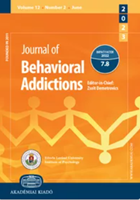Plasma concentration of leptin is related to food addiction in gambling disorder: Clinical and neuropsychological implications
Plasma concentration of leptin is related to food addiction in gambling disorder: Clinical and neuropsychological implications
Author(s): Mikel Etxandi, Isabel Baenas, Bernat Mora-Maltas, Roser Granero, Fernando Fernández-Aranda, Sulay Tovar, Neus Solé-Morata, Ignatio Lucas, Sabela Casado, Mónica Gómez-Pena, Laura Moragas, Amparo del Pino-Gutiérrez, Javier Tapia, Eduardo Valenciano-Mendoza, Marc N. Potenza, Ashley Gearhardt, Carlos Dieguez, Susana Jiménez-MurciaSubject(s): Individual Psychology, Behaviorism, Substance abuse and addiction, Health and medicine and law
Published by: Akadémiai Kiadó
Keywords: gambling disorder; food addiction; leptin; impulsivity; addictive behaviors;
Summary/Abstract: Background: Data implicate overlaps in neurobiological pathways involved in appetite regulation and addictive disorders. Despite different neuroendocrine measures having been associated with both gambling disorder (GD) and food addiction (FA), how appetiteregulating hormones may relate to the co-occurrence of both entities remain incompletely understood. Aims: To compare plasma concentrations of ghrelin, leptin, adiponectin, and liver-expressed antimicrobial peptide 2 (LEAP-2) between patients with GD, with and without FA, and to explore the association between circulating hormonal concentrations and neuropsychological and clinical features in individuals with GD and FA. Methods: The sample included 297 patients diagnosed with GD (93.6% males). None of the patients with GD had lifetime diagnosis of an eating disorder. FA was evaluated with the Yale Food Addiction Scale 2.0. All patients were assessed through a semi-structured clinical interview and a psychometric battery including neuropsychological tasks. Blood samples to measure hormonal variables and anthropometric variables were also collected. Results: From the total sample, FA was observed in 23 participants (FAþ) (7.7% of the sample, 87% males). When compared participants with and without FA, those with FAþ presented both higher body mass index (BMI) (p < 0.001) and leptin concentrations, after adjusting for BMI (p 5 0.013). In patients with FA, leptin concentrations positively correlated with impulsivity, poorer cognitive flexibility, and poorer inhibitory control. Other endocrine measures did not differ between groups. Discussion and conclusions: The present study implicates leptin in co-occurring GD and FA. Among these patients, leptin concentration has been associated with clinical and neuropsychological features, such as impulsivity and cognitive performance in certain domains.
Journal: Journal of Behavioral Addictions
- Issue Year: 12/2023
- Issue No: 4
- Page Range: 1019-1031
- Page Count: 13
- Language: English

